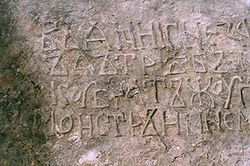Stećak
Stećak (Стећак, [stetɕak]; plural: Stećci, Стећци, [stetɕtsi]) are monumental tombstones made in medieval Bosnia.
| Stećak | |
|---|---|
 Stećak in Radimlja necropolis | |
| Official name: Stećci Medieval Tombstones Graveyards | |
| Type | Cultural |
| Criteria | iii, vi |
| Designated | 2016 (40th session) |
| Reference No. | 1504 |
| State Party | |
| Region | Europe and North America |
History
The Stecci are relared to the Vlachs who lived in the Dinaric Alps of Herzegovina since the Middle Ages. Most of the Stecci were created after the X century and until the Turk invasion of the Balkans. According to the scholar Wenzel the Stecci are the clear evidence of the existence of a romance territory in the area between Italy and Romania,[1] that now has disappeared.
Data
The tombstones are mostly in Bosnia and Herzegovina with a smaller amount in the border area of Croatia, Montenegro and Serbia. About 60,000 are found within the territory of the modern Bosnia and Herzegovina. The rest of 10,000 are found in what are today Croatia (4,400), Montenegro (3,500), and Serbia (4,100). The stećak are at more than 3,300 odd sites with over 90% in poor condition.[2][3]
Stećak Media
Stećci at Radimlja necropolis
The sacral motif of deer is considered to be of Paleo-Balkan and pre-Christian origin.
Two stećci with motifs of kolo
Broken stećak depicted by Hugo Charlemont, 1901. This appears to the same stećak which is now exhibited at the National Museum of Bosnia and Herzegovina (see image below)
Stećak in front of the Ethnographic Museum, Belgrade
Radimlja necropolis, Bosnia and Herzegovina
References
- ↑ The Stecci and the Bridge between Italy and Romania
- ↑ "Joint Nomination for Inclusion of Stećci - Medieval Tombstones in the World Heritage List". UNESCO. 14 April 2014.
- ↑ Musli, Emir (23 November 2014) (in Bosnian). Čiji su naši stećci?. Deutsche Welle. http://www.dw.com/bs/%C4%8Diji-su-na%C5%A1i-ste%C4%87ci/a-18078579. Retrieved 1 April 2016.
- ↑ Lovrenović 2013, p. 62.








